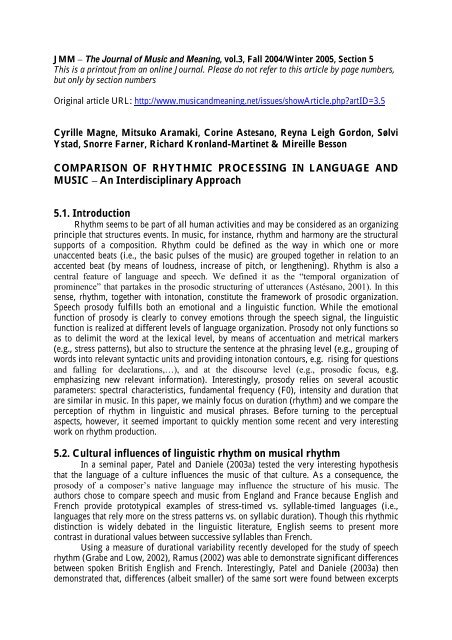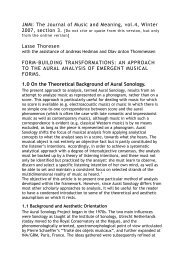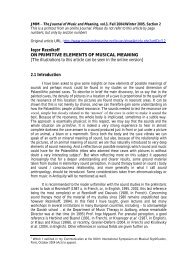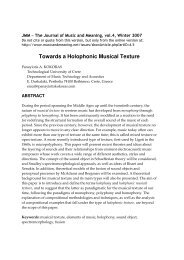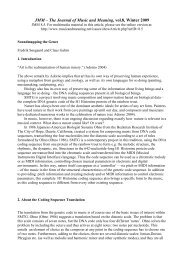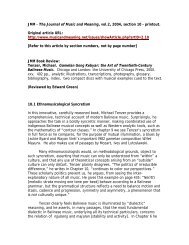Print Article - Journal of Music and Meaning
Print Article - Journal of Music and Meaning
Print Article - Journal of Music and Meaning
Create successful ePaper yourself
Turn your PDF publications into a flip-book with our unique Google optimized e-Paper software.
JMM –The <strong>Journal</strong> <strong>of</strong> <strong>Music</strong> <strong>and</strong> <strong>Meaning</strong>, vol.3, Fall 2004/Winter 2005, Section 5<br />
This is a printout from an online <strong>Journal</strong>. Please do not refer to this article by page numbers,<br />
but only by section numbers<br />
Original article URL: http://www.music<strong>and</strong>meaning.net/issues/show<strong>Article</strong>.php?artID=3.5<br />
Cyrille Magne, Mitsuko Aramaki, Corine Astesano, Reyna Leigh Gordon, Sølvi<br />
Ystad, Snorre Farner, Richard Kronl<strong>and</strong>-Martinet & Mireille Besson<br />
COMPARISON OF RHYTHMIC PROCESSING IN LANGUAGE AND<br />
MUSIC –An Interdisciplinary Approach<br />
5.1. Introduction<br />
Rhythm seems to be part <strong>of</strong> all human activities <strong>and</strong> may be considered as an organizing<br />
principle that structures events. In music, for instance, rhythm <strong>and</strong> harmony are the structural<br />
supports <strong>of</strong> a composition. Rhythm could be defined as the way in which one or more<br />
unaccented beats (i.e., the basic pulses <strong>of</strong> the music) are grouped together in relation to an<br />
accented beat (by means <strong>of</strong> loudness, increase <strong>of</strong> pitch, or lengthening). Rhythm is also a<br />
central feature <strong>of</strong> language <strong>and</strong> speech. We defined it as the “temporal organization <strong>of</strong><br />
prominence” that partakes in the prosodic structuring <strong>of</strong> uterances (Astésano, 2001). In this<br />
sense, rhythm, together with intonation, constitute the framework <strong>of</strong> prosodic organization.<br />
Speech prosody fulfills both an emotional <strong>and</strong> a linguistic function. While the emotional<br />
function <strong>of</strong> prosody is clearly to convey emotions through the speech signal, the linguistic<br />
function is realized at different levels <strong>of</strong> language organization. Prosody not only functions so<br />
as to delimit the word at the lexical level, by means <strong>of</strong> accentuation <strong>and</strong> metrical markers<br />
(e.g., stress patterns), but also to structure the sentence at the phrasing level (e.g., grouping <strong>of</strong><br />
words into relevant syntactic units <strong>and</strong> providing intonation contours, e.g. rising for questions<br />
<strong>and</strong> faling for declarations,…), <strong>and</strong> at the discourse level (e.g., prosodic focus, e.g.<br />
emphasizing new relevant information). Interestingly, prosody relies on several acoustic<br />
parameters: spectral characteristics, fundamental frequency (F0), intensity <strong>and</strong> duration that<br />
are similar in music. In this paper, we mainly focus on duration (rhythm) <strong>and</strong> we compare the<br />
perception <strong>of</strong> rhythm in linguistic <strong>and</strong> musical phrases. Before turning to the perceptual<br />
aspects, however, it seemed important to quickly mention some recent <strong>and</strong> very interesting<br />
work on rhythm production.<br />
5.2. Cultural influences <strong>of</strong> linguistic rhythm on musical rhythm<br />
In a seminal paper, Patel <strong>and</strong> Daniele (2003a) tested the very interesting hypothesis<br />
that the language <strong>of</strong> a culture influences the music <strong>of</strong> that culture. As a consequence, the<br />
prosody <strong>of</strong> a composer’s native language may influence the structure <strong>of</strong> his music. The<br />
authors chose to compare speech <strong>and</strong> music from Engl<strong>and</strong> <strong>and</strong> France because English <strong>and</strong><br />
French provide prototypical examples <strong>of</strong> stress-timed vs. syllable-timed languages (i.e.,<br />
languages that rely more on the stress patterns vs. on syllabic duration). Though this rhythmic<br />
distinction is widely debated in the linguistic literature, English seems to present more<br />
contrast in durational values between successive syllables than French.<br />
Using a measure <strong>of</strong> durational variability recently developed for the study <strong>of</strong> speech<br />
rhythm (Grabe <strong>and</strong> Low, 2002), Ramus (2002) was able to demonstrate significant differences<br />
between spoken British English <strong>and</strong> French. Interestingly, Patel <strong>and</strong> Daniele (2003a) then<br />
demonstrated that, differences (albeit smaller) <strong>of</strong> the same sort were found between excerpts
<strong>of</strong> English <strong>and</strong> French instrumental music. Thus, these results support the idea that the<br />
linguistic rhythm <strong>of</strong> a language leaves an imprint on its musical rhythm.<br />
These results were then extended by Huron <strong>and</strong> Ollen (2003) to a larger sample <strong>of</strong><br />
musical themes by Brown (2000), including not only a larger sample <strong>of</strong> English <strong>and</strong> French<br />
music than in the Patel <strong>and</strong> Daniele (2003a) study, but also music from many other countries<br />
(e.g., Norwegian, Polish, Russian <strong>and</strong> Italian). Overall, they replicated the differences<br />
between English <strong>and</strong> French music reported in the previous study. Moreover, they also found<br />
that the durational variability index value for Austrian <strong>and</strong> German music was closer to<br />
Spanish, Italian <strong>and</strong> French music than to American or English music. Ins<strong>of</strong>ar as Austrian <strong>and</strong><br />
German are stress-timed languages, like English, <strong>and</strong> following the idea that linguistic rhythm<br />
influences musical rhythm, the reverse was expected (Austrian <strong>and</strong> German closer to English<br />
than to some syllable-timed languages, such as Italian). By examining these data from an<br />
historical perspective (as a function <strong>of</strong> the composer’s birth year), Patel <strong>and</strong> Daniele (2003b)<br />
were able to show that the values <strong>of</strong> the durational variability index increase with time,<br />
possibly reflecting less influence from Italian musical style on Austrian <strong>and</strong> German music<br />
over the years. Note, however, that for most Austrian <strong>and</strong> German composers, values <strong>of</strong> the<br />
durational variability index are smaller than the averaged value for Italian composers. In any<br />
event, these results open the interesting possibility that historical influences <strong>of</strong> one musical<br />
culture on the other may sometimes outweigh linguistic influences on music within the same<br />
culture.<br />
These results are interesting in that they demonstrate that the rhythmic structure <strong>of</strong> a<br />
language may exert an overall influence on musical composition, <strong>and</strong> therefore clearly<br />
emphasize the similarities between linguistic <strong>and</strong> musical rhythmic production. We now turn<br />
to the perception <strong>of</strong> rhythm in speech <strong>and</strong> music<br />
5.3. Why is interdisciplinarity a necessity?<br />
In order to design experiments aiming at a better underst<strong>and</strong>ing as to how the rhythmic<br />
structure <strong>of</strong> a language, or <strong>of</strong> a piece <strong>of</strong> music, influences or determines its perception, it is<br />
absolutely necessary to combine <strong>and</strong> use knowledge from different research domains. First,<br />
we need to find the most important characteristics <strong>of</strong> the rhythmic structure <strong>of</strong> our language or<br />
music stimuli in order to manipulate the relevant parameters. Consequently, both phoneticians<br />
<strong>and</strong> musicologists are strongly needed. Second, we need to be able to manipulate speech <strong>and</strong><br />
musical signals to effectuate fine transformations <strong>and</strong> construct high-quality stimuli.<br />
Consequently, acousticians are strongly needed. Third, we need to determine how the<br />
manipulations that are introduced within the speech or musical signals are perceived by the<br />
volunteers who participate to the experiment. Thus, to be able to draw significant conclusions,<br />
it is necessary to build up clear experimental designs, based on the methods developed in<br />
experimental psychology. Consequently, both psycho-linguists <strong>and</strong> psycho-musicologists are<br />
strongly needed. Finally, if we are interested in the computations carried out in the brain that<br />
support auditory perception <strong>and</strong> cognition, we strongly need neuroscientists. In the example<br />
reported below, we conducted a series <strong>of</strong> experiments that required the collaboration among<br />
researchers from the fields <strong>of</strong> phonetics, acoustics, psychology <strong>and</strong> neuroscience.<br />
5.4. An example <strong>of</strong> interdisciplinary approach<br />
Recent results in the field <strong>of</strong> phonetics have led some authors to propose that, in French,<br />
words are marked by an initial stress (melodic stress) <strong>and</strong> a final stress or final lengthening<br />
(Di Cristo, 1999; Astésano, 2001). However, as the initial stress is secondary, the basic<br />
French metric pattern is iambic, meaning that words or groups <strong>of</strong> words are marked by a final<br />
lengthening. Therefore, final syllabic lengthening is very important for our perception <strong>and</strong><br />
underst<strong>and</strong>ing <strong>of</strong> a spoken language, since it allows the marking <strong>of</strong> the end <strong>of</strong> groups <strong>of</strong> words<br />
<strong>and</strong> <strong>of</strong> sentences in an otherwise continuous flow <strong>of</strong> auditory information. Interestingly, based
on research in the music domain, Repp (1992) also considered that final lengthening is a<br />
widespread musical phenomenon that manifests itself in musicians' performance in the form<br />
<strong>of</strong> deviations from the steady beat that is present in the underlying representation. As in<br />
speech, final lengthening in music primarily allows a demarcation <strong>of</strong> structural boundaries<br />
between musical phrases. Based on these (phonetic <strong>and</strong> musical) considerations, we decided<br />
to manipulate final syllabic lengthening in language <strong>and</strong> final note lengthening in music.<br />
The aim <strong>of</strong> the experiments that we conducted was three-fold. First, we wanted to<br />
determine whether such rhythmic cues as final syllabic <strong>and</strong> note lengthening are perceived in<br />
real time by the listeners. It was therefore <strong>of</strong> uttermost importance to build up linguistic <strong>and</strong><br />
musical materials that matched this goal. This required a strong collaboration between<br />
phoneticians <strong>and</strong> acousticians. Second, it was <strong>of</strong> interest to determine whether the violation <strong>of</strong><br />
final syllabic or note lengthening would hinder perception <strong>and</strong>/or comprehension <strong>of</strong> the<br />
linguistic <strong>and</strong> musical phrases. Moreover, we wanted to examine the relationship between<br />
rhythmic <strong>and</strong> semantic processing in language, on the one h<strong>and</strong>, <strong>and</strong> between rhythmic <strong>and</strong><br />
harmonic processing in music, on the other h<strong>and</strong>. Therefore, we built an experimental design<br />
that comprised four experimental conditions (see below), <strong>and</strong> we recorded both the time it<br />
took for the participants to give their answers (i.e., Reaction Times, RTs) <strong>and</strong> the error<br />
percentage. Finally, we wanted to compare the effects obtained with speech <strong>and</strong> music in<br />
order to determiner whether the perceptual <strong>and</strong> cognitive computations involved are specific<br />
to one domain or, by contrast, rely on general cognitive processes. Interestingly, Brown<br />
(2001) <strong>and</strong> others have also suggested that music <strong>and</strong> speech may have a common origin in a<br />
pre-semantic musilanguage. In this case, we could find similarities between speech <strong>and</strong> music<br />
that would be specific to both, but not necessarily dependent upon general perceptive or<br />
cognitive processes.<br />
Note that while behavioral data such as RTs <strong>and</strong> error rates provide an excellent<br />
measure <strong>of</strong> the level <strong>of</strong> performance for a given task, they do not allow the study <strong>of</strong> perceptual<br />
<strong>and</strong> cognitive processing <strong>of</strong> final syllabic <strong>and</strong> note lengthening as they unfold in real time.<br />
Thus, we needed a method with an excellent time resolution. The Event-Related Brain<br />
Potentials (ERPs) method is perfectly suited for this purpose, because it allows for the timetracking<br />
<strong>of</strong> information processing. Before summarizing the different steps <strong>of</strong> this<br />
interdisciplinary venture - building up the materials <strong>and</strong> the experimental design, analyzing<br />
the results <strong>and</strong> discussing their implications - we first quickly describe the main reasons for<br />
using the ERPs method.<br />
5.4.1. The ERPs method<br />
By placing electrodes on the scalp <strong>of</strong> human volunteers, it is possible to record the<br />
variations <strong>of</strong> the brain electrical activity, known as the Electro-Encephalogram (EEG, Berger,<br />
1929). The EEG being <strong>of</strong> small amplitude (<strong>of</strong> the order <strong>of</strong> 100 microvolts, µV), such analog<br />
signals are amplified <strong>and</strong> then converted to digital signals (see Figure 1). Interestingly, any<br />
stimulus, be it a sound, a light, a touch, a smel, etc… elicits changes, or variations <strong>of</strong><br />
potentials, in the background EEG. However, such variations are very small (<strong>of</strong> the order <strong>of</strong><br />
10 µV) compared to the background EEG activity. It is therefore necessary to synchronize the<br />
EEG recording to the onset <strong>of</strong> the stimulation, <strong>and</strong> to sum <strong>and</strong> average a large number <strong>of</strong> trials<br />
in which similar stimulations were presented. As a consequence, the signal - that is, the<br />
variations <strong>of</strong> potential evoked by the stimulation (or Evoked Potentials or Event-Related<br />
Potentials, ERPs) - will emerge from the background noise linked to the EEG activity (see<br />
Figure 2). Typically, in perceptual <strong>and</strong> cognitive experiments, 20 to 30 stimulations belonging<br />
to the same experimental condition need to be averaged to obtain a good signal-to-noise ratio.<br />
The ERPs comprises a series <strong>of</strong> positive <strong>and</strong> negative deflections, called components, relative<br />
to the baseline, that is, the averaged level <strong>of</strong> brain electrical activity during 100 or 200<br />
milliseconds (ms) before the stimulation. Components are defined by their polarity (negative,
N, or positive, P), their latency from stimulus onset (100, 200, 300, 400 ms, etc…), their scalp<br />
distribution (location <strong>of</strong> the maximum amplitude on the scalp) <strong>and</strong> their sensitivity to<br />
experimental factors. Typically, the ERPs recorded in perceptual <strong>and</strong> cognitive experiments,<br />
comprise early components that reflect the sensory <strong>and</strong> perceptual stages <strong>of</strong> information<br />
processing (e.g., P100, N100 <strong>and</strong> P200) <strong>and</strong> later components that reflect cognitive stages <strong>of</strong><br />
procesing (e.g., P300, N400, etc…). ERPs are analyzed using different latency windows,<br />
centred around the maximum amplitude, or the peak amplitude, <strong>of</strong> the component <strong>of</strong> interest<br />
(e.g., 300-600 ms latency window to analyze the N400 component) <strong>and</strong> the mean amplitude<br />
within this latency b<strong>and</strong> is computed (see Rugg & Coles, 1995 for an overview <strong>of</strong> the ERP<br />
method).<br />
-----------------------------------------------------------<br />
Figures 1 <strong>and</strong> 2<br />
[See online version]<br />
-----------------------------------------------------------<br />
5.4.2. Construction <strong>of</strong> stimuli <strong>and</strong> design <strong>of</strong> the experiments<br />
For the language part <strong>of</strong> the experiment, we created 128 sentences ending with<br />
trisylabic words (i.e. “Les musiciens ont composé une mélodie” [“The musicians composed a<br />
melody”]). The sentences were read by a native French man <strong>and</strong> recorded in an anechoic<br />
room. The last word <strong>of</strong> each sentence was further segmented in three syllables, making it<br />
possible to measure the final syllabic lengthening for each final word, which in our case was<br />
found to be 1.7 times the average length <strong>of</strong> the non-stressed syllables. This ratio is within the<br />
range, 1.7 –2.1, previously reported as average final syllable lengthening <strong>of</strong> words in<br />
prosodic groups in French (Astésano, 2001). In order to determine whether syllabic<br />
lengthening is processed in real time, that is, while participants listened to the sentences, we<br />
created rhythmic incongruities by lengthening the penultimate syllable, instead <strong>of</strong> the final<br />
syllable, <strong>of</strong> the last word <strong>of</strong> the sentence. For this purpose, we developed a time-stretching<br />
algorithm that allowed us to manipulate the duration <strong>of</strong> the acoustic signal, without altering<br />
timbre or frequency (Pallone, 1999, Ystad et al., 2005). For the incongruity to remain natural,<br />
the lengthening was based on the ratio 1.7. Moreover, to examine the relationship between<br />
rhythmic <strong>and</strong> semantic processing, we also created semantic incongruities by replacing the<br />
last word <strong>of</strong> the congruous sentences by a word that was unexpected (i.e., it did not make<br />
sense) in the sentence context (i.e. “Les musiciens ont composé une bigamie.” [“The<br />
musicians composed a bigamy”]).<br />
By independently manipulating rhythmic <strong>and</strong> semantic congruency <strong>of</strong> the trisyllabic<br />
final words, we created four experimental conditions in which the last word <strong>of</strong> the sentence<br />
was rhythmically <strong>and</strong> semantically congruous (R+S+); rhythmically congruous <strong>and</strong><br />
semantically incongruous (R+S-); rhythmically incongruous et semantically congruous (R-<br />
S+); <strong>and</strong>, rhythmically <strong>and</strong> semantically incongruous (R-S-).<br />
In the music experiment, we used sequences <strong>of</strong> five to nine major <strong>and</strong> minor chords<br />
that were diatonic in the given key <strong>and</strong> followed the rules <strong>of</strong> Western harmony. Simple<br />
melodies were composed (by one French researcher, two Norwegian researchers <strong>and</strong> one<br />
American researcher with different musical backgrounds) out <strong>of</strong> these chord progressions by<br />
playing each chord as a 3-note arpeggio. This choice was related to the language experiment<br />
in which the last words in the sentences always were three-syllabic words. Indeed, while we<br />
certainly do not regard a syllable in language as being equal to a note in music, it was useful,<br />
for the purposes <strong>of</strong> the experiment, to try to isolate aspects <strong>of</strong> language that it would make<br />
sense to postulate as corresponding to aspects <strong>of</strong> music. Therefore, the rhythmic <strong>and</strong> harmonic<br />
incongruities were obtained from modifications <strong>of</strong> the penultimate note <strong>of</strong> the last triad <strong>of</strong> the<br />
melody. The rhythmic incongruity was created by lengthening the penultimate note by a ratio<br />
<strong>of</strong> 1.7 as in the language experiment. Finally, to be consistent with the language experiment in
which the first syllable <strong>of</strong> the last word did not necessarily indicate whether or not the last<br />
word was incongruous, the first note <strong>of</strong> the last triad was harmonically congruent with both<br />
the beginning <strong>and</strong> the end <strong>of</strong> the melody. Thus, disharmony could only be perceived from the<br />
second note <strong>of</strong> the last triad (sound examples illustrating these stimuli are available at<br />
http://www.lma.cnrs-mrs.fr/~kronl<strong>and</strong>/JMM/sounds.html).<br />
To summarize, as in the language experiment, we independently manipulated rhythmic<br />
<strong>and</strong> harmonic congruencies to create four experimental conditions, in which the last three<br />
notes <strong>of</strong> the sentence were 1) both rhythmically <strong>and</strong> harmonically congruous (R+H+), 2)<br />
rhythmically incongruous <strong>and</strong> harmonically congruous (i.e., the penultimate note was<br />
lengthened, R-H+), 3) harmonically incongruous <strong>and</strong> rhythmically congruous (i.e., the<br />
penultimate note was transposed, R+H-) <strong>and</strong> 4) both rhythmically <strong>and</strong> harmonically<br />
incongruous (i.e., both lengthened <strong>and</strong> transposed, R-H-).<br />
Within both the language <strong>and</strong> music experiments, the participants were asked to focus<br />
their attention on the rhythm <strong>of</strong> the last word/arpeggio in half <strong>of</strong> the trials, <strong>and</strong> to decide<br />
whether its rhythm was acceptable or not (Rhythmic Task). In the other half <strong>of</strong> the trials, the<br />
participants were asked to focus their attention on the meaning (Harmonic structure) <strong>of</strong> the<br />
sentence (melody), <strong>and</strong> to decide whether the last word/arpeggio was acceptable in the<br />
context or not (Semantic/Harmonic Task).<br />
5.4.3. Results <strong>and</strong> discussion<br />
A total <strong>of</strong> 14 participants were tested in the language experiment <strong>and</strong> a total <strong>of</strong> 8<br />
participants were tested in the music experiment. Volunteers were students from the Aix-<br />
Marseille Universities <strong>and</strong> were paid to participate in the experiments that lasted for about 2<br />
hours (including the installation <strong>of</strong> the Electro-Cap). They were 23-years-old on the average,<br />
<strong>and</strong> right-h<strong>and</strong>ed with no known auditory deficit.<br />
Results <strong>of</strong> the language experiment showed that rhythmic processing seems to be taskdependent<br />
(see Figure 3). Indeed, when participants focused their attention on the rhythmic<br />
aspects (left column, Meter), words that were semantically congruous <strong>and</strong> rhythmically<br />
incongruous (S+R-) elicited a larger positive component, peaking around 700 ms poststimulus<br />
onset (P700), than semantically <strong>and</strong> rhythmically congruous words (S+R+). In<br />
contrast, when participants listened to the very same sentences, but focused their attention on<br />
the semantic aspects (right column, Semantic), words that were semantically congruous <strong>and</strong><br />
rhythmically incongruous (S+R-) elicited a larger negative component, peaking around 400<br />
ms post-stimulus onset (N400) than semantically <strong>and</strong> rhythmically congruous words (R+S+).<br />
-----------------------------------------------------------<br />
Figure 3<br />
[See online version]<br />
-----------------------------------------------------------<br />
In contrast, preliminary results <strong>of</strong> the music experiment, suggest that the effects<br />
elicited by the rhythmic incongruity are task-independent (see Figure 4). Indeed, regardless <strong>of</strong><br />
the specific aspect, rhythmic or harmonic, on which participants focused their attention,<br />
harmonically congruous <strong>and</strong> rhythmically incongruous musical sequences (R-H+) elicited a<br />
larger biphasic negative-positive complex between 200 <strong>and</strong> 900 ms (N300-P600) than<br />
harmonically <strong>and</strong> rhythmically congruous sequences (R+H+).<br />
-----------------------------------------------------------<br />
Figure 4<br />
[See online version]<br />
-----------------------------------------------------------
These preliminary results on the processing <strong>of</strong> rhythm in both speech <strong>and</strong> music<br />
already point to interesting similarities <strong>and</strong> differences. Considering the similarities first, it is<br />
clear that the rhythmic structure is processed on-line in both language <strong>and</strong> music. Indeed,<br />
rhythmic incongruities elicited a different pattern <strong>of</strong> brain waves than rhythmically congruous<br />
events. Moreover, it is worth noting that the processing <strong>of</strong> these rhythmic incongruities was<br />
associated with increased positive deflections in the Brain Potential in similar latency b<strong>and</strong>s in<br />
both language (P700) <strong>and</strong> music (P600). However, while these positive components were<br />
present in music under both attentional conditions (rhythmic <strong>and</strong> harmonic tasks), they were<br />
only present in the rhythmic task in the language experiment. Thus, while the processing <strong>of</strong><br />
rhythm may be obligatory when listening to the short melodic sequences presented here, it<br />
seems to be modulated by attention when listening to the linguistic sentences.<br />
Turning to the differences, it is interesting to note that while the positive components<br />
were preceded by negative components (N300) in music under both attentional conditions, no<br />
such negativities were found in language in the rhythmic task. Thus, again, rhythmic<br />
violations seem to elicit earlier (N300) <strong>and</strong> larger (N300-P600) brain responses in music than<br />
in language (only P700). Interestingly, in the semantic task <strong>of</strong> the language experiment,<br />
negative components (N400) were elicited by semantically congruent but rhythmically<br />
incongruous words (S+R-). This finding may seem surprising in the context <strong>of</strong> a large body <strong>of</strong><br />
literature showing that semantically congruous words (i.e., words that are expected within a<br />
sentence context such as “c<strong>and</strong>idates” in Le concours a regroupé mille c<strong>and</strong>idats) typically<br />
elicit much smaller N400 components than semantically incongruous words, a result generally<br />
interpreted as reflecting larger integration dificulties for incongruous words (e.g., “Le<br />
concours a regroupé mille bigoudis”). Therefore, our results seem to indicate that the<br />
lengthening <strong>of</strong> the penultimate syllable disturbs access to word meaning <strong>and</strong> consequently<br />
increases difficulties in the integration <strong>of</strong> the word meaning within the sentence context.<br />
These findings, by pointing to the influence <strong>of</strong> metrical structure, may have important<br />
consequences for our underst<strong>and</strong>ing <strong>of</strong> the factors that contribute to lexical access <strong>and</strong> word<br />
meaning. More generally, they demonstrate the important role <strong>of</strong> lexical prosody in speech<br />
processing.<br />
In conclusion, by briefly presenting our research project on the perception <strong>of</strong> rhythm<br />
in both language <strong>and</strong> music, we tried to illustrate the strong need for interdisciplinarity in<br />
order to conduct such experiments. Moreover, our results open interesting perspectives: for<br />
instance, using the functional Magnetic Resonance Imaging (fMRI) method to determine<br />
whether similar or different networks <strong>of</strong> brain structures are involved in the processing <strong>of</strong> the<br />
rhythmic structures in language <strong>and</strong> music. More generally, following up our previous work<br />
(Schön et al., 2004; Magne et al., 2003) showing that musical training facilitates the<br />
perception <strong>of</strong> changes in fundamental frequency, not only in music, but also in language, we<br />
will test transfer <strong>of</strong> learning from musical to linguistic rhythm. Recent experiments with<br />
dyslexic children tend, for instance, to demonstrate that classroom music lessons had<br />
beneficial effects on both rhythm copying <strong>and</strong> phonological <strong>and</strong> spelling abilities (Overy,<br />
2003).
References<br />
Astésano C. (2001) Rythme et accentuation en français. Invariance et variabilité stylistique.<br />
Editions L’Harmatan, Colection Langue & Parole.<br />
Berger, H. (1929). Uber das Electrenkephalogramm das Menchen. Archiv für Psychiatrie,<br />
87:527-570.<br />
Besson, M., F. Faïta, C. Czternasty & M. Kutas. (1997). What's in a Pause: Event-Related<br />
Potential Analysis <strong>of</strong> Temporal Disruptions in Written <strong>and</strong> Spoken Sentences. Biological<br />
Psychology 46:3-23.<br />
Besson, M., & Macar, F. (1987). An Event-Eelated Potentials Analysis <strong>of</strong> Incongruity in<br />
<strong>Music</strong> <strong>and</strong> Other Non-Linguistic Contexts. Psychophysiology, 24:14-25.<br />
Besson, M. & D. Schön. (2002). Comparison Between Language <strong>and</strong> <strong>Music</strong>. In The<br />
Biological Foundations <strong>of</strong> <strong>Music</strong>, R. Zatorre & I. Peretz, Eds., Science <strong>and</strong> Medical<br />
Publications, Oxford University Press, Oxford.<br />
Brown (2000). The “Musilanguage” Model <strong>of</strong> <strong>Music</strong> Evolution. In The Origins <strong>of</strong> <strong>Music</strong>. Eds<br />
N.L. Wallin, B. Merker <strong>and</strong> S. Brown, MIT Press, Cambridge, Massachussetts.<br />
Di Cristo, A. (1999). Le cadre accentuel du français contemporain: essai de modélisation (1 ère<br />
partie). Langues, 2 (3), 184-205.<br />
Duez, D. & Nishinuma, Y. (1985) "Le rythme en français: alternance des durées syllabiques",<br />
Travaux de l'Institut de Phonétique d'Aix, Vol. 10, 151-169.<br />
Gabrielsson, A. (1982) "Perception <strong>and</strong> Performance <strong>of</strong> <strong>Music</strong>al Rhythm", in <strong>Music</strong>, Mind<br />
<strong>and</strong> Brain. The Neuropsychology <strong>of</strong> <strong>Music</strong>. 'An exp<strong>and</strong>ed version <strong>of</strong> proceedings from the<br />
Third Workshop on the Physical <strong>and</strong> Neuropsychological Foundations <strong>of</strong> <strong>Music</strong>, held in<br />
August 8-12, 1980, in Ossiach, Austria', Manfred Clynes (ed.), Plenum Press. New York.,<br />
159-169.<br />
Grabe, E., & Low, E. L. (2002). Durational Variability in Speech <strong>and</strong> the Rhythm Class<br />
Hypothesis. In C. Gussenhoven & N. Warner, Laboratory phonology (pp. 515–546). 7.<br />
Berlin: Mouton de Gruyter.<br />
Huron, D. & Ollen, J. (2003). Agogic Contrast in French <strong>and</strong> English Themes: Further<br />
Support for Patel <strong>and</strong> Daniele (2003). <strong>Music</strong> Perception, 21: 267-272.<br />
Magne, C., Schön, D., & Besson, M. (2003). Prosodic <strong>and</strong> Melodic Processing in Adults <strong>and</strong><br />
Children: Behavioural <strong>and</strong> Electrophysiological Approaches. Annals <strong>of</strong> the New York<br />
Academy <strong>of</strong> Sciences, 999:461-476.<br />
Nishinuma, Y. & Duez, D. (1987) "Étude perceptive de l'organisation temporelle de l'énoncé<br />
en français", Travaux de l'Institut de Phonétique d'Aix, 11, 184-201.<br />
Overy, K. (2003) Dyslexia <strong>and</strong> <strong>Music</strong>: From Timing Deficits to <strong>Music</strong>al Intervention. Ann.<br />
N.Y. Acad.Sci. 999:497-505.<br />
Pallone, G., Boussard,P. , Daudet, L., Guillemain, P., Kronl<strong>and</strong>-Martinet, R. (1999) A<br />
Wavelet Based Method for Audio Video Synchronization in Broadcasting Applications. In<br />
proceedings <strong>of</strong> the DAFX'99, Trondheim, Norway, Dec 9-11.<br />
Patel, A.D, & Daniele, J.R. (2003a). An Empirical Comparison <strong>of</strong> Rhythm in Language <strong>and</strong><br />
<strong>Music</strong>. Cognition, 87: B35-B45.<br />
Patel, A.D, & Daniele, J.R. (2003b). Stressed-Timed Vs. Syllable-Timed <strong>Music</strong>? A Comment<br />
on Huron <strong>and</strong> Ollen. <strong>Music</strong> Perception, 21: 273-276.<br />
Patel, A., Gibson, E., Ratner, J., Besson, M. & Holcomb, P. (1998). Processing Syntactic<br />
Relations in Language <strong>and</strong> <strong>Music</strong>: An Event-Related Potential Study. <strong>Journal</strong> <strong>of</strong> Cognitive<br />
Neuroscience, 10:717-733.<br />
Ramus, F. (2002). Acoustic Correlates <strong>of</strong> Linguistic Rhythm: Perspectives. Proceedings <strong>of</strong><br />
Speech Prosody 2002, Aix-en-Provence (pp. 115–120). Aix-en-Provence: Laboratoire<br />
Parole et Langage.
Repp, B. (1992) "Probing the Cognitive Representation <strong>of</strong> <strong>Music</strong>al Time: Structural<br />
Constraints on the Perception <strong>of</strong> Timing Perturbations.", Haskins Laboratories Status<br />
Report on Speech Research, 111/112, New Haven, Connecticut, 293-320.<br />
Rugg, M & Coles, M.G.H. (1995). Electrophysiology <strong>of</strong> Mind: Event-Related Brain<br />
Potentials <strong>and</strong> Cognition. Oxford Psychology Series, 25. Oxford.<br />
Schön, D., Magne, C., & Besson, M. (2004). The <strong>Music</strong> <strong>of</strong> Speech: Electrophysiological<br />
Study <strong>of</strong> Pitch Perception in Language <strong>and</strong> <strong>Music</strong>. Psychophysiology, 41, 341-349.<br />
Touati, P. (1987) "Structures prosodiques du suédois et du français : pr<strong>of</strong>ils temporels et<br />
configurations tonales.", Travaux de l'Institut de Linguistique de Lund, Vol. 21, Lund<br />
University Press.


